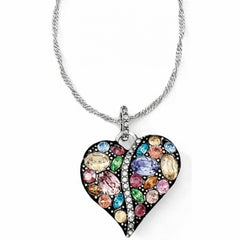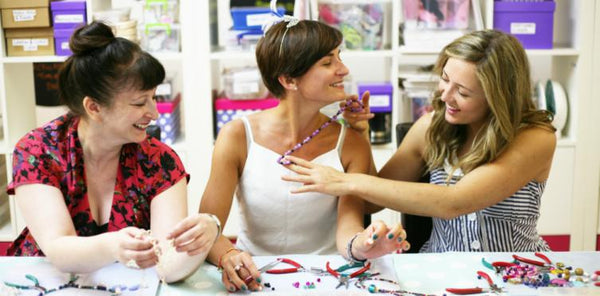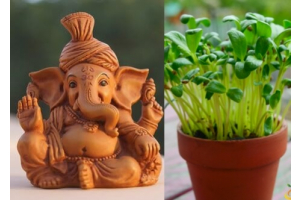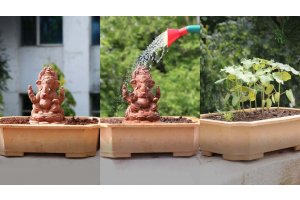Making your own jewellery is not only a fun and addictive hobby, it also has the added benefit that you get to wear what you create! However, many people don’t really know where to start.
Threads
---
Leather thong is popular for its natural qualities. It may be stiff when first bought but soon softens. It is available in a variety of colours and thicknesses. Leather thong is fairly strong but thin sizes (less than 1mm in thickness) should not be used for single stranded necklaces. It is solid so it doesn’t fray which makes threading relatively easy.
Nymo loom thread is ideal when using a beadloom. It is very strong, yet fine enough to go through the smallest bead holes. It is also great for making jewellery with small holed beads off the loom.
Super lon D is another handy thread and is marginally stronger than Nymo. It has a very smooth finish. Both come in a variety of colours to match your beads. Both threads need to be used with a beading needle. Wildfire is a thermally bonded, waterproof bead weaving thread that is abrasion resistant, won't fray and has virtually no stretch. It’s ideal for stringing seed beads and, because of its strength it works especially well with multi-strand necklaces. It comes in several neutral tones.
Wildfire is a thermally bonded, waterproof bead weaving thread that is abrasion resistant, won't fray and has virtually no stretch. It’s ideal for stringing seed beads and, because of its strength it works especially well with multi-strand necklaces. It comes in several neutral tones.
Cotton thong aka bootlace or ‘veggie leather’ is overtaking genuine leather in popularity. Although it looks similar to genuine leather thong it is more consistent in thickness and quality. It is significantly stronger than leather and is more economical. One minor drawback with cotton thong is that it is woven and may therefore fray a little when used with tight fitting beads.
Silk thread is more costly but can give an attractive and professional looking finish when knotted between each bead. Two colours knotted together make an interesting look. It comes with its own threader, making threading through even very tiny holes easy. It is very strong and supple, ideal for special pieces of jewellery.
Nylon thread passes easily through very tiny holes, without requiring a needle. Its transparent qualities make it unobtrusive, an advantage with certain designs. However, it is a little difficult to knot and can hang somewhat awkwardly unless beads of some weight are used. In time it may stretch. Nylon thread benefits from a dab of glue or nail varnish on knots to strengthen them.
Waxed thread is easy to thread, easy to knot and very strong. This irresistible combination of factors makes it the most versatile of threads. It is particularly suitable for filled necklaces of smaller beads. The only disadvantage is its colour range. It is available in white, white or white! It’s slightly less versatile relative, black linen thread, makes a good substitute when a little of the thread is likely to show.

Beading wires such as Tigertail and Beadalon are the strongest threads available. They consist of a base of twisted steel wire, coated in nylon. They make the best long term solution for heavier necklaces featuring glass and other materials that may have sharp edges. Beading wires are strong yet sensitive. They are not happy being knotted and have a tendency to form kinks if care is not taken. One exception to the rule is Beadalon which is kink resistant. Just like a rain mac, note that the key word is ‘resistant’ and not ‘proof’. If you are looking for cheap and cheerful, plastic coated beading wire is perfect. Its zingy colours make it the extrovert of the beading world.
Beading wires are excellent for ‘floating’ necklaces where beads are separated along the wire by crimps. Here’s how to use your crimping pliers:

- a) Thread the crimp onto the beading wire. Press the crimp shut using the hole closest to the pliers handle. This gives your crimp a fold in the middle.
- b) Flatten the crimp with the hole closest to the pliers tip for a neat finish.
- c) Add a small holed bead and a crimp on the other side.
Wires, Chains and Other Alternatives to Thread
There are a number of attractive and simple alternatives to using threads. Your creations can be striking and uncomplicated but be aware that versatility is not the most prominent feature of these products.
Metal chokers are pre-formed circles of stiff wire with a loop on each side to close. A single pendant piece will thread on in a moment. If you are very careful you can straighten one end out to enable yourself to add some large holed beads. Gently re-bend the wire once you are satisfied with your arrangement (img 1.)

Memory wire retains its shape, hence its title. It is similar to the metal choker in that it is pre-shaped in a range of ready cut lengths. Non ready cut lengths are also available. It is thinner than the metal choker and does not already have pre-formed ends. It is therefore quick and easy to add a wide variety of beads and pendants. When you have added your beads or pendant bend the end into a loop (like the metal choker above). If you are feeling really creative, curl the very end to make a decorative loop (img 2.)
Elasticity is a soft, flexible bead cord which looks like nylon but stretches like elastic. Its limber nature makes it perfect for bracelets particularly when using beads with a small hole. Take one piece of wrist length elasticity and add your beads. Knot the elasticity tightly (but not too tightly) together at the ends. Glue the knot for extra security if you wish. It couldn’t be easier!
Chain can be put to a large range of uses. Charm bracelets have made a big comeback and bag charms have become extremely popular in recent years. A variety of weights are available. Popular choices are 3mm (lightweight) and 5mm (heavyweight). A very delicate chain called trace chain (2mm) is also available and this is perfect if you want to make a dainty looking necklace. Short lengths can be separated by beads on eyepins for a bohemian look. As well as gold and silver plated, other colours such as black antique are also available.

Trace chain (2mm) is also available and this is perfect if you want to make a dainty looking necklace. Short lengths can be separated by beads on eyepins for a bohemian look. As well as gold and silver plated, other colours such as black antique are also on the market.
You may also come across Extension chain is also available. This is a short length of chain with a fastener attached. It can be added to an existing necklace or bracelet to add extra length.
Finishing off
Clasps
 Depending on the thread you have chosen and on personal taste there are several different ways to finish your necklace. Things to consider are the thickness of the thread, the length of the piece you are making and the ease with which you need to put on and take off your jewellery. There is of course a clasp to suit every taste and style. Here are just a few examples.
Depending on the thread you have chosen and on personal taste there are several different ways to finish your necklace. Things to consider are the thickness of the thread, the length of the piece you are making and the ease with which you need to put on and take off your jewellery. There is of course a clasp to suit every taste and style. Here are just a few examples.Hooks are a simple way to finish. Some have a spring arm so they close completely, giving extra security.
Screw clasps come in two parts which screw together. Some have loops at each end.
Magnetic clasps are similar in appearance to screw clasps, but as the name suggests, the two parts simply clip together magnetically. They are ideal for lightweight necklaces or bracelets and are great if you have trouble with fiddly fastenings.
Box clasps have an inner mechanism which is secure yet very easy to do up and undo, even one handed. Box clasps are also available with two or three loops at each end, for multi-strand necklaces.
Bolt rings are used with tags. They are suitable for bracelets and daintier necklaces as they are small and unobtrusive.

How to attach the thread to the clasp
A thin flexible medium such as waxed thread is a good combination with a clasp with loops, a box clasp, bolt ring or hook. A calotte is then used to attach the thread to the clasp. The calotte covers unsightly knots and includes a loop onto which you can attach your clasp. To give your knot a little extra ‘body’ simply pass the end of the thread back through the knot a second time (img 1.)
Lay the knot inside the hollow of the calotte and squeeze it tightly closed. Trim the loose strands which stick out at the top. Open the loop on the calotte and attach it to the clasp(img 2.)
Beading wire can be unhappy when knotted. Use a tiny crimp, squeezed tightly with the half-round/flat-nosed pliers. A crimp cover will improve the finish (img 3.)

A leather or cotton thong necklace can be finished in a number of ways. Leather crimps combined with a hook is most popular, particularly for shorter necklaces and chokers. There are two basic types of leather crimps, round (or spring end) crimps and flat crimps (img 4.)
For round crimps ensure a tight fit, doubling the cord if necessary. Grip the end coil and squeeze gently but firmly with the half-round / flat-nosed pliers until the spiral has tightened on the cord and is secure. It will help if you keep the end of the spring facing you. Squeeze the end coil only. Add a hook to one loop. This will attach to the loop on the opposite crimp (img 5.)
For flat crimps fold the end of the cord double if it will fit comfortably, and lay it inside the crimp. Fold each side of the crimp down in turn and squeeze tight with the half-round / flat-nosed pliers. Add a hook to one crimp loop and a split ring to the other. A clasp can happily be substituted for a hook (img 6.).

--------

***





